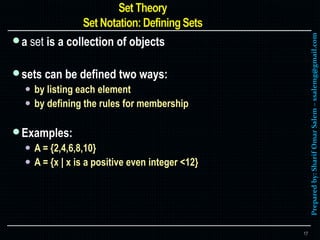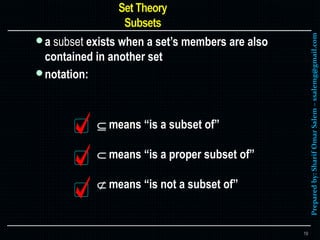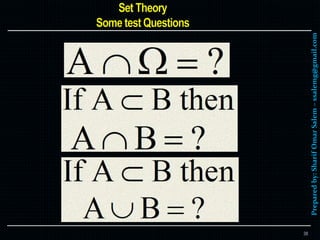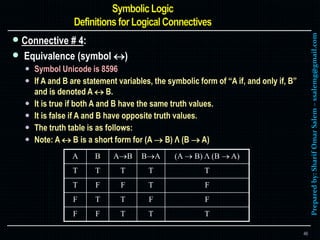Ad
#2 formal methods – principles of logic
- 1. Preparedby:SharifOmarSalem–[email protected] Prepared by: Sharif Omar Salem – [email protected] 0
- 2. Preparedby:SharifOmarSalem–[email protected] Historical View Set Theory Symbolic Logic Truth Tables 1
- 3. Preparedby:SharifOmarSalem–[email protected] Philosophical Logic 500 BC (Before Christ) to 19th Century Symbolic Logic Mid to late 19th Century Mathematical Logic Late 19th to mid 20th Century Logic in Computer Science 2
- 4. Preparedby:SharifOmarSalem–[email protected] 500 B.C – 19th Century Logic dealt with arguments in the natural language used by humans. Example All men are moral. Socrates is a man Therefore, Socrates is moral. 3
- 5. Preparedby:SharifOmarSalem–[email protected] Natural language is very ambiguous. Eric does not believe that Mary can pass any test. I only borrowed your car. Tom hates Jim and he likes Mary. It led to many paradoxes. “This sentence is a lie.” (The Liar’s Paradox) 4
- 6. Preparedby:SharifOmarSalem–[email protected] Mid to late 19th Century. Attempted to formulate logic in terms of a mathematical language Rules of inference were modeled after various laws for manipulating algebraic expressions. 5
- 7. Preparedby:SharifOmarSalem–[email protected] Late 19th to mid 20th Century Frege proposed logic as a language for mathematics in 1879. With the rigor of this new foundation, Cantor was able to analyze the notion of infinity in ways that were previously impossible. (2N is strictly larger than N) Russell’s Paradox T = { S | S ∉ S} 6
- 8. Preparedby:SharifOmarSalem–[email protected] In computer science, we design and study systems through the use of formal languages that can themselves be interpreted by a formal system. Boolean circuits Programming languages Design Validation and verification AI, Security. Etc. 7
- 9. Preparedby:SharifOmarSalem–[email protected] Propositional Logic First Order Logic Higher Order Logic Theory of Construction Real-time Logic, Temporal Logic Process Algebras Linear Logic 8
- 10. Preparedby:SharifOmarSalem–[email protected] Understanding set theory helps people to … see things in terms of systems organize things into groups begin to understand logic 9
- 11. Preparedby:SharifOmarSalem–[email protected] These mathematicians influenced the development of set theory and logic: Georg Cantor John Venn George Boole Augustus DeMorgan 10
- 12. Preparedby:SharifOmarSalem–[email protected] developed set theory set theory was not initially accepted because it was radically different set theory today is widely accepted and is used in many areas of mathematics 11 the concept of infinity was expanded by Cantor’s set theory Cantor proved there are “levels of infinity” an infinitude of integers initially ending with or an infinitude of real numbers exist between 1 and 2; there are more real numbers than there are integers…
- 13. Preparedby:SharifOmarSalem–[email protected] John Venn 1834-1923 studied and taught logic and probability theory articulated Boole’s algebra of logic devised a simple way to diagram set operations (Venn Diagrams) 12 George Boole 1815-1864 self-taught mathematician with an interest in logic developed an algebra of logic (Boolean Algebra) featured the operators and or not nor (exclusive or)
- 14. Preparedby:SharifOmarSalem–[email protected] developed two laws of negation interested, like other mathematicians, in using mathematics to demonstrate logic furthered Boole’s work of incorporating logic and mathematics formally stated the laws of set theory 13
- 15. Preparedby:SharifOmarSalem–[email protected] A set is a collection of elements An element is an object contained in a set If every element of Set A is also contained in Set B, then Set A is a subset of Set B A is a proper subset of B if B has more elements than A does The universal set contains all of the elements relevant to a given discussion 14
- 16. Preparedby:SharifOmarSalem–[email protected] the universal set is a deck of ordinary playing cards each card is an element in the universal set some subsets are: face cards numbered cards suits poker hands 15
- 17. Preparedby:SharifOmarSalem–[email protected] Symbol Meaning Upper case designates set name Lower case designates set elements { } enclose elements in set or is (or is not) an element of is a subset of (includes equal sets) is a proper subset of is not a subset of is a superset of | or : such that (if a condition is true) | | the cardinality of a set 16
- 18. Preparedby:SharifOmarSalem–[email protected] a set is a collection of objects sets can be defined two ways: by listing each element by defining the rules for membership Examples: A = {2,4,6,8,10} A = {x | x is a positive even integer <12} 17
- 19. Preparedby:SharifOmarSalem–[email protected] an element is a member of a set notation: means “is an element of” means “is not an element of” Examples: A = {1, 2, 3, 4} 1 A 6 A 2 A z A B = {x | x is an even number 10} 2 B 9 B 4 B z B 18
- 20. Preparedby:SharifOmarSalem–[email protected] a subset exists when a set’s members are also contained in another set notation: means “is a subset of” means “is a proper subset of” means “is not a subset of” 19
- 21. Preparedby:SharifOmarSalem–[email protected] A = {x | x is a positive integer 8} set A contains: 1, 2, 3, 4, 5, 6, 7, 8 B = {x | x is a positive even integer 10} set B contains: 2, 4, 6, 8 C = {2, 4, 6, 8, 10} set C contains: 2, 4, 6, 8, 10 Subset Relationships A A A B A C B A B B B C C A C B C C 20
- 22. Preparedby:SharifOmarSalem–[email protected] Two sets are equal if and only if they contain precisely the same elements. The order in which the elements are listed is unimportant. Elements may be repeated in set definitions without increasing the size of the sets. Examples: A = {1, 2, 3, 4} B = {1, 4, 2, 3} A B and B A; therefore, A = B and B = A A = {1, 2, 2, 3, 4, 1, 2} B = {1, 2, 3, 4} A B and B A; therefore, A = B and B = A 21
- 23. Preparedby:SharifOmarSalem–[email protected] Cardinality refers to the number of elements in a set A finite set has a countable number of elements An infinite set has at least as many elements as the set of natural numbers notation: |A| represents the cardinality of Set A Set Definition Cardinality A = {x | x is a lower case letter} |A| = 26 B = {2, 3, 4, 5, 6, 7} |B| = 6 A = {1, 2, 3, …} |A| = 22
- 24. Preparedby:SharifOmarSalem–[email protected] The universal set is the set of all things pertinent to to a given discussion and is designated by the symbol U Example: U = {all students at LUCT} Some Subsets: A = {all Computer Technology students} B = {freshmen students} C = {sophomore students} 23
- 25. Preparedby:SharifOmarSalem–[email protected] Any set that contains no elements is called the empty set the empty set is a subset of every set including itself notation: { } or Examples ~ both A and B are empty A = {x | x is a Proton Civic car} B = {x | x is a positive number 0} 24
- 26. Preparedby:SharifOmarSalem–[email protected] The power set is the set of all subsets that can be created from a given set The cardinality of the power set is 2 to the power of the given set’s cardinality notation: P (set name) Example: A = {a, b, c} where |A| = 3 P (A) = {{a, b}, {a, c}, {b, c}, {a}, {b}, {c}, A, } and |P (A)| = 8 In general, if |A| = n, then |P (A) | = 2n 25
- 27. Preparedby:SharifOmarSalem–[email protected] Z represents the set of integers Z+ is the set of positive integers and Z- is the set of negative integers N represents the set of natural numbers ℝ represents the set of real numbers Q represents the set of rational numbers 26
- 28. Preparedby:SharifOmarSalem–[email protected] Venn diagrams show relationships between sets and their elements 27
- 29. Preparedby:SharifOmarSalem–[email protected] Set Definition Elements A = {x | x Z+ and x 8} 1 2 3 4 5 6 7 8 B = {x | x Z+; x is even and 10} 2 4 6 8 10 A B B A 28
- 30. Preparedby:SharifOmarSalem–[email protected] Set Definition Elements A = {x | x Z+ and x 9} 1 2 3 4 5 6 7 8 9 B = {x | x Z+ ; x is even and 8} 2 4 6 8 A B B A A B 29
- 31. Preparedby:SharifOmarSalem–[email protected] Set Definition U = {1, 2, 3, 4, 5, 6, 7, 8} A = {1, 2, 6, 7} B = {2, 3, 4, 7} C = {4, 5, 6, 7} 30 A = {1, 2, 6, 7}
- 32. Preparedby:SharifOmarSalem–[email protected] “A union B” is the set of all elements that are in A, or B, or both. This is similar to the logical “or” operator. A B A BÈ 31
- 33. Preparedby:SharifOmarSalem–[email protected] “A intersect B” is the set of all elements that are in both A and B. This is similar to the logical “and” A B A BÇ 32
- 34. Preparedby:SharifOmarSalem–[email protected] “A complement,” or “not A” is the set of all elements not in A. The complement operator is similar to the logical not, and is reflexive, that is, A A 33
- 35. Preparedby:SharifOmarSalem–[email protected] The set difference “A minus B” is the set of elements that are in A, with those that are in B subtracted out. Another way of putting it is, it is the set of elements that are in A, and not in B, so A B A B Ç 34
- 40. Preparedby:SharifOmarSalem–[email protected] Symbolic logic is a collection of languages that use symbols to represent facts, events, and actions, and provide rules to symbolize reasoning. Given the specification of a system and a collection of desirable properties, both written in logic formulas, we can attempt to prove that these desirable properties are logical consequences of the specification. 39
- 41. Preparedby:SharifOmarSalem–[email protected] Definition of a statement: A statement, also called a proposition, is a sentence that is either true or false, but not both. Hence the truth value of a statement is T (1) or F (0) Examples: Which ones are statements? All mathematicians wear sandals. 5 is greater than –2. Where do you live? You are a cool person. Anyone who wears sandals is an algebraist. 40
- 42. Preparedby:SharifOmarSalem–[email protected] An example to illustrate how logic really helps us (3 statements written below): All LUCT staff wear Black. Anyone who wears black is an employee. Therefore, all LUCT staff are employees. Logic is of no help in determining the individual truth of these statements. Logic helps in concluding fact from another facts (reasoning) However, if the first two statements are true, logic assures the truth of the third statement. Logical methods are used in mathematics to prove theorems and in computer science to prove that programs do what they are supposed to do. 41
- 43. Preparedby:SharifOmarSalem–[email protected] Usually, letters like A, B, C, D, etc. are used to represent statements. Logical connectives are symbols such as Λ , V , , , ’ Λ represents and, V represents or, represents equivalence, represents implication, ‘ represents negation. A statement form or propositional form is an expression made up of statement variables (such as A, B, and C) and logical connectives (such as Λ, V, , ) Example: (A V B) (B Λ C) 42
- 44. Preparedby:SharifOmarSalem–[email protected] Connective # 1: Conjunction “AND” (symbol Λ) Symbol Unicode is 8743 If A and B are statement variables, the conjunction of A and B is A Λ B, which is read “A and B”. A Λ B is true when both A and B are true. A Λ B is false when at least one of A or B is false. A and B are called the conjuncts of A Λ B. 43 A B AΛ B T T T T F F F T F F F F
- 45. Preparedby:SharifOmarSalem–[email protected] Connective # 2: Disjunction “OR” (symbol V) Symbol Unicode is 8744 If A and B are statement variables, the disjunction of A and B is A V B, which is read “A or B”. A V B is true when at least one of A or B is true. A V B is false when both A and B are false. 44 A B A V B T T T T F T F T T F F F
- 46. Preparedby:SharifOmarSalem–[email protected] Connective # 3: Implication (symbol ) Symbol Unicode is 8594 If A and B are statement variables, the symbolic form of “if A then B” is A B. This may also be read “A implies B” or “A only if B.” “If A then B” is false when A is true and B is false, and it is true otherwise. Note: A B is true if A is false, regardless of the truth of B 45 A B AB T T T T F F F T T F F T
- 47. Preparedby:SharifOmarSalem–[email protected] Connective # 4: Equivalence (symbol ) Symbol Unicode is 8596 If A and B are statement variables, the symbolic form of “A if, and only if, B” and is denoted A B. It is true if both A and B have the same truth values. It is false if A and B have opposite truth values. The truth table is as follows: Note: A B is a short form for (A B) Λ (B A) 46 A B AB BA (A B) Λ (B A) T T T T T T F F T F F T T F F F F T T T
- 48. Preparedby:SharifOmarSalem–[email protected] Connective #5: Negation (symbol ) Symbol Unicode is 0732 If A is a statement variable, the negation of A is “not A” and is denoted A. It has the opposite truth value from A: if A is true, then A is false; if A is false, then A is true. Example of a negation: A: 5 is greater than –2 A : 5 is less than –2 B: She likes butter B : She dislikes butter / She hates butter Sometimes we use the symbol ¬ for negation 47 A A T F F T
- 49. Preparedby:SharifOmarSalem–[email protected] A truth table is a table that displays the truth values of a statement form which correspond to the different combinations of truth values for the variables. 48 A A T F F T A B AΛ B T T T T F F F T F F F F A B A V B T T T T F T F T T F F F A B AB T T T T F F F T T F F T A B AB T T T T F F F T F F F T
- 50. Preparedby:SharifOmarSalem–[email protected] Combining letters, connectives, and parentheses can generate an expression which is meaningful, called a wff. e.g. (A B) V (B A) is a wff but A )) V B ( C) is not To reduce the number of parentheses, an order is stipulated in which the connectives can be applied, called the order of precedence, which is as follows: Connectives within innermost parentheses first and then progress outwards Negation () Conjunction (Λ), Disjunction (V) Implication () Equivalence () Hence, A V B C is the same as (A V B) C 49
- 51. Preparedby:SharifOmarSalem–[email protected] The truth table for the wff A V B (A V B) shown below. The main connective, according to the rules of precedence, is implication. 50 A B B A V B A V B (A V B) A V B (A V B) T T F T T F F T F T T T F F F T F F T F T F F T T F T T
- 52. Preparedby:SharifOmarSalem–[email protected] Definition of tautology (VALIDITY): A wff that is intrinsically true, i.e. no matter what the truth value of the statements that comprise the wff. e.g. It will rain today or it will not rain today ( A V A ) P Q where P is A B and Q is A V B Definition of a contradiction (Unsatisfy): A wff that is intrinsically false, i.e. no matter what the truth value of the statements that comprise the wff. e.g. It will rain today and it will not rain today ( A Λ A ) (A Λ B) Λ A Usually, tautology is represented by 1 and contradiction by 0 51
- 53. Preparedby:SharifOmarSalem–[email protected] Two statement forms are called logically equivalent if, and only if, they have identical truth values for each possible substitution of statements for their statement variables. The logical equivalence of statement forms P and Q is denoted by writing P Q or P Q. Truth table for (A V B) V C A V (B V C) 52 A B C A V B B V C (A V B) V C A V (B V C) T T T T T T T T T F T T T T T F T T T T T T F F T F T T F T T T T T T F T F T T T T F F T F T T T F F F F F F F
- 54. Preparedby:SharifOmarSalem–[email protected] The equivalences are listed in pairs, hence they are called duals of each other. One equivalence can be obtained from another by replacing V with Λ and 0 with 1 or vice versa. Prove the distributive property using truth tables. 53 Commutative A V B B V A AΛ B B Λ A Associative (A V B) V C A V (B V C) (AΛ B) Λ C AΛ (B Λ C) Distributive A V (B Λ C) (A V B) Λ (A V C) AΛ (B V C) (AΛ B) V (AΛ C) Identity A V 0 A AΛ 1 A Complement A V A 1 AΛ A 0
- 55. Preparedby:SharifOmarSalem–[email protected] 1. (A V B) A Λ B 2. (A Λ B) A V B 54 A B A B A V B (A V B) A Λ B T T F F T F F T F F T T F F F T T F T F F F F T T F T T
- 56. Preparedby:SharifOmarSalem–[email protected] Prepared by: Sharif Omar Salem – [email protected] 55
- 57. Preparedby:SharifOmarSalem–[email protected] Prepared by: Sharif Omar Salem – [email protected] 56
















































































![Data Structures - Lecture 10 [Graphs]](https://cdn.slidesharecdn.com/ss_thumbnails/datastructures-lecture10graphs-150305004608-conversion-gate01-thumbnail.jpg?width=560&fit=bounds)















![Set-notation--venn-diagrams-and-probability [Read-Only].pptx](https://cdn.slidesharecdn.com/ss_thumbnails/set-notation-venn-diagrams-and-probabilityread-only-230226040754-ad241515-thumbnail.jpg?width=560&fit=bounds)
![Set-notation--venn-diagrams-and-probability [Read-Only].pptx](https://cdn.slidesharecdn.com/ss_thumbnails/set-notation-venn-diagrams-and-probabilityread-only-230226041002-f0e1951e-thumbnail.jpg?width=560&fit=bounds)



























